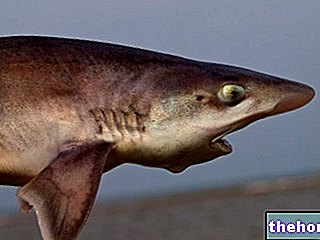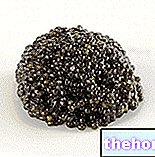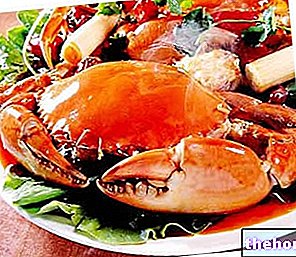Generality
Shrimp are macruri crustaceans, therefore provided with a long, distended abdomen and with a fan-shaped tail fin; in fact, the term "shrimp" is extremely generic since it embraces a wide range of species belonging to Type, Family, Superfamily And Suborder different.

- Domain Eukaryota, Kingdom Animalia, Phylum Eumetazoa, Class Malacostraca and Order Decapoda
- Small size.
NB. By carefully observing the various Decapod Macruri crustaceans, therefore also scampi, lobsters ed lobsters, it is clear that each of them possesses all the morphological requisites typical of shrimps; however, in the common language (and not in the zoological classification), it is the DIMENSIONS and some anatomical peculiarities that distinguish the shrimps (or shrimps, if even smaller) from the rest of the Macruri Decapod crustaceans.
Distinction between shrimps
The most commercialized shrimps for HUMAN nutrition are those of salt water even if, in some areas, those of fresh water play a very respectable nutritional role. Shrimps are also part of the diet of numerous aquatic and underwater species, therefore, their capture can be aimed at supporting specific fish farms (such as salmon).
Ultimately, shrimp can be classified by:
- Habitat (freshwater or saltwater shrimp)
- Origin (Italian or Mediterranean prawns and oceanic prawns).
Edible salt water shrimp
The shrimp "properly called" live at all bathymetrics, colonize almost the entire planet and often are morphologically different from each other; listing all the shrimp species would not be of any help to the readers, therefore we will try to illustrate more clearly below. the most interesting breeds compared to the usual shrimps (Argentine, blue, Californian etc.) present in the freezers of supermarkets or on the counters of fish markets.
- Prawns Mazzancolla: genus Penaeus (family Penaeidae), the species are very numerous and widespread. The Italian / Mediterranean prawn shrimp has a light color, between white and gray, which however fluctuates according to the seabed. It lives in depths between 5 and 50m and reaches 20cm per 100g of weight. It is very valuable and (in Italy) is known as the Imperial Shrimp or Spannocchia.
- Indo-Pacific shrimps or prawns: type Metapenaeus (family Penaeidae); there are some species and they are ALL larger shrimps than the aforementioned category. They are generally products of ocean fishing, mainly from the Indian and Pacific.
- Sea shrimp:
- Prawns Boreal: Latin name Pandalus borealis (family Pandalidae); it colonizes both the Atlantic Ocean and the Pacific Ocean and lives between 0 and 9 ° C up to 400m of depth. It boasts a notable alimentary and commercial importance.
- Rockpool Prawn shrimp: Latin name Palaemon elegans (family Palaemonidae); 12-13cm long, it is transparent and lives mainly in the light. It is present in the Mediterranean and in the Atlantic Ocean.
- Common prawn prawns: Latin name Palaemon serratus (family Palaemonidae); about 6cm long, it is whitish and lives mainly in the shade or in the dark. It is present in the Mediterranean and in the Atlantic Ocean.
- Posidonia shrimp: Latin name Palaemon xiphias (family Palaemonidae); lives in Madeira, on the Canary Islands and in the Mediterranean Sea; it is present between 0.5 and 10 m deep in the middle of Posidonia oceanica and rarely in algal meadows.
Freshwater shrimp
As far as inland waters are concerned, several edible shrimps can be found on the Italian territory (although not all native):
- Italian crayfish: there are several species: Austropotamobius pallipes, Astacus astacus and Austropotamobius torrentium; they are indigenous prawns quite concentrated in the cold waters of series A (streams, lakes, hill rivers, etc.). They are prevalent in the Friuli Venezia Giulia region but it is not uncommon to find them in the hilly streams of the Apennines; they are also widespread in some lakes in northern Italy and in central Italy. Crayfish need clean, cold and unpolluted waters.
- Allochthonous shrimp: there are several species: Procambarus clarkii ("Killer" shrimp), Orconectes limosus, Pacifastacus leniusculus And Astacus leptodactylus; the best known are the "Killer". They are shrimp originating from the lower valley of the Mississippi River (USA) but are currently widespread in many other areas of the planet (Sudan, Thailand, some European countries, etc.). In Italy they are often confused with the European crayfish but they are distinguished from these by some morphological details and a GREATER adaptability. These shrimp resist polluted waters and are often colonized in low-altitude lake creeks, drains and all low-altitude temperate waters.
- Fresh and brackish water shrimps: Palaemon antennarius (family Palaemonidae) And Atyaephyra you would desmarinate (family Atyidae); they are both indigenous prawns but, unlike the Italian crayfish, they have small dimensions and a transparent or brownish-striped color. They colonize practically all the waterways of the peninsula but do not reach the most impetuous streams. L "Atyaephyra you would desmarinate it also tolerates salt water well and is very present on the coasts of the northern Adriatic where the salinity is not excessive. In coastal fishing and near the mouths, in the spring period, it is often caught together with some breeds of sea shrimp.
storage
Shrimps are highly perishable foods; they, like many other crustaceans, contain high quantities of free amino acids which, together with muscle proteins (both by their own enzymatic degradation and by bacterial degradation), significantly contribute to the release of nitrogen and to the onset of an unpleasant odor of ammonia. to remedy this inconvenience, the shrimps are blast chilled on board the fishing boats and some species can be pre-cooked.
Shrimps are also subject to food addition with sulphites; these preservatives are used to slow down the browning process of the head and the loss of body color. Therefore, contrary to what could be deduced, the freshest shrimps always have a dark head (a process that takes place in a very short time) while those treated with sulphites, despite having a bright color, may have been fished or thawed long ago. A shrimp with sulphites reaches rot earlier than the browning of the head.
Shrimp in the kitchen
Shrimps are suitable for countless preparations: raw food, an ingredient for sauces accompanying first courses or sauces, grilled dishes, pan-fried dishes, fried dishes and steamed dishes. The main precautions to be taken into account are:
- Shrimps should be cleaned by eliminating the intestine, not for hygienic reasons but for taste pleasantness
- Shrimps need FAST cooking, those prolonged inexorably ruin the food
- Shrimp cooked on the grill should retain the shell that maintains its softness, as well as medium-sized ones to be fried should be peeled to speed up the frying process.
It is necessary to keep in mind that shrimps are the subject of a very widespread allergic form; therefore they are foods not recommended for feeding the pregnant woman, the nurse and the infant.
How to Clean Prawns
Problems with playing the video? Reload the video from youtube.
- Go to the Video Page
- Go to the Video Recipes Section
- Watch the video on youtube
Nutritional characteristics
Shrimps are foods of animal origin; they provide modest amounts of energy, most of which comes from proteins with a high biological value.There is also little fat and a CONSISTENT portion of cholesterol. Carbohydrates are present but irrelevant.
As for vitamins, shrimp provide good amounts of riboflavin (vit. B2), niacin (vit. PP) and, in some species, also a retinol equivalent called astaxanthin (very powerful antioxidant).
Shrimp are also rich in sodium, iron, potassium, phosphorus, and calcium.
The shrimp carapace contains a NON digestible polysaccharide, the chitin; this, which, when treated with basic solutions, originates the chitosan, is part of the wide range of dietary supplements aimed at slimming. Its effect should be of a chelating type on fats but the results are of little or no significance.


Bibliography:
- The fauna in Italy - A. Minelli - Ministry of the environment and territorial protection - page 188
- Food composition tables - National Research Institute for Food and Nutrition (INRAN)
Fish, Molluscs, Crustaceans Anchovies or Anchovies Garfish Alaccia Eel Lobster Herring Lobster Whitebait Bottarga Sea bass (Sea bass) Squid Canocchie Scallops Canestrelli (Sea scallops) Capitone Caviar Mullet Monkfish (Monkfish) Mussels Crustaceans Dates Sea Fruits Fish Flour Fauna Fish stock Prawns Crabs Spider crab (Granceola) Halibut Sea salad Lanzardo Leccia Sea snails Prawns Cod Molluscs Octopus Hake Ombrina Oysters Sea bream Bonito Pangasius Paranza Anchovy paste Fresh seasonal fish Blue fish Puffer fish Swordfish Plaice Octopus (Octopus) Hedgehog of Sea Amberjack Salmon Sardines Sardines Scampi Cuttlefish Mackerel Sole Stockfish Surimi Sushi Telline Tuna Canned tuna Mullet Trout Fish roe Bluefish Clams OTHER FISH ARTICLES Categories Alcoholic Food Meat Cereals and derivatives Sweeteners Sweets Offal Fruit Dried fruit Milk and derivatives Legumes Oils and fats Fish andpeach products Salami Spices Vegetables Health recipes Appetizers Bread, Pizza and Brioche First courses Second courses Vegetables and Salads Sweets and Desserts Ice creams and sorbets Syrups, liqueurs and grappa Basic preparations ---- In the kitchen with leftovers Carnival recipes Christmas Light diet recipes Women's, mom's and dad's day recipes Functional recipes International recipes Easter recipes Celiac recipes Diabetic recipes Holiday recipes Valentine's Day recipes Vegetarian recipes Protein recipes Regional recipes Vegan recipes




























